When it comes to Search Engine Optimisation (SEO), content is still king.
But without keyword research and targeting, the likelihood of this content reaching anybody is next to none.
After all, what are you optimizing for if not keywords?
Without them, all SEO efforts are just shots in the dark in the hope that some relevant traffic will find its way to our website.
In fact, without keywords search engines just wouldn’t do anything except produce random pages of websites.
…what we are trying to say is – keywords are important.
With this in mind, it is crazy to see that so few websites properly research keywords and apply best practices in order to rank for them.
Although it can take some time and effort to rank your website for keywords, the potential upsides of following a proper SEO process are huge.
This is especially true for sites that rely heavily on high volumes of relevant traffic such as ecommerce stores.
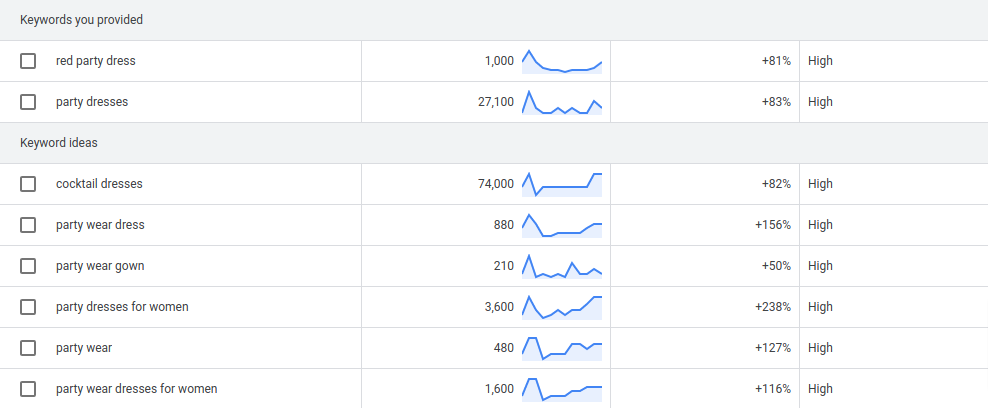
In this guide, we are going to walk you through everything you need to know about long-tail keywords.
This is an important area for those that want to increase the quality of traffic they drive to their site. It will also help you avoid competing with other businesses and organizations that have well-established websites and huge SEO budgets.
In this guide, we will cover:
- What long-tail keywords are
- How long-tail keywords work
- The benefits of targeting long-tail keywords
- What makes a good long-tail keyword
- How to find the best long-tail keywords for your website
Ready to become a long-tail pro? Want to attract lots of high-value traffic to your website? Then read on…
What are Long-Tail Keywords?
We are going to kick this guide off with the most fundamental thing you need to know about long-tail keywords…what they are.
Let’s break it down.
From a Search Engine Optimisation perspective the term ‘keyword’ is used to describe a specific word that could connect a search engine user’s query with a particular piece of content.
Let’s take for example the keyword “guitar”.
When you type ‘guitar’ into a search engine such as Google you will be presented with results that Google thinks best match that keyword. You can see from the screenshot below that this search term actually returns several recent news articles about guitars as well as a Wikipedia page for the term ‘guitar’.
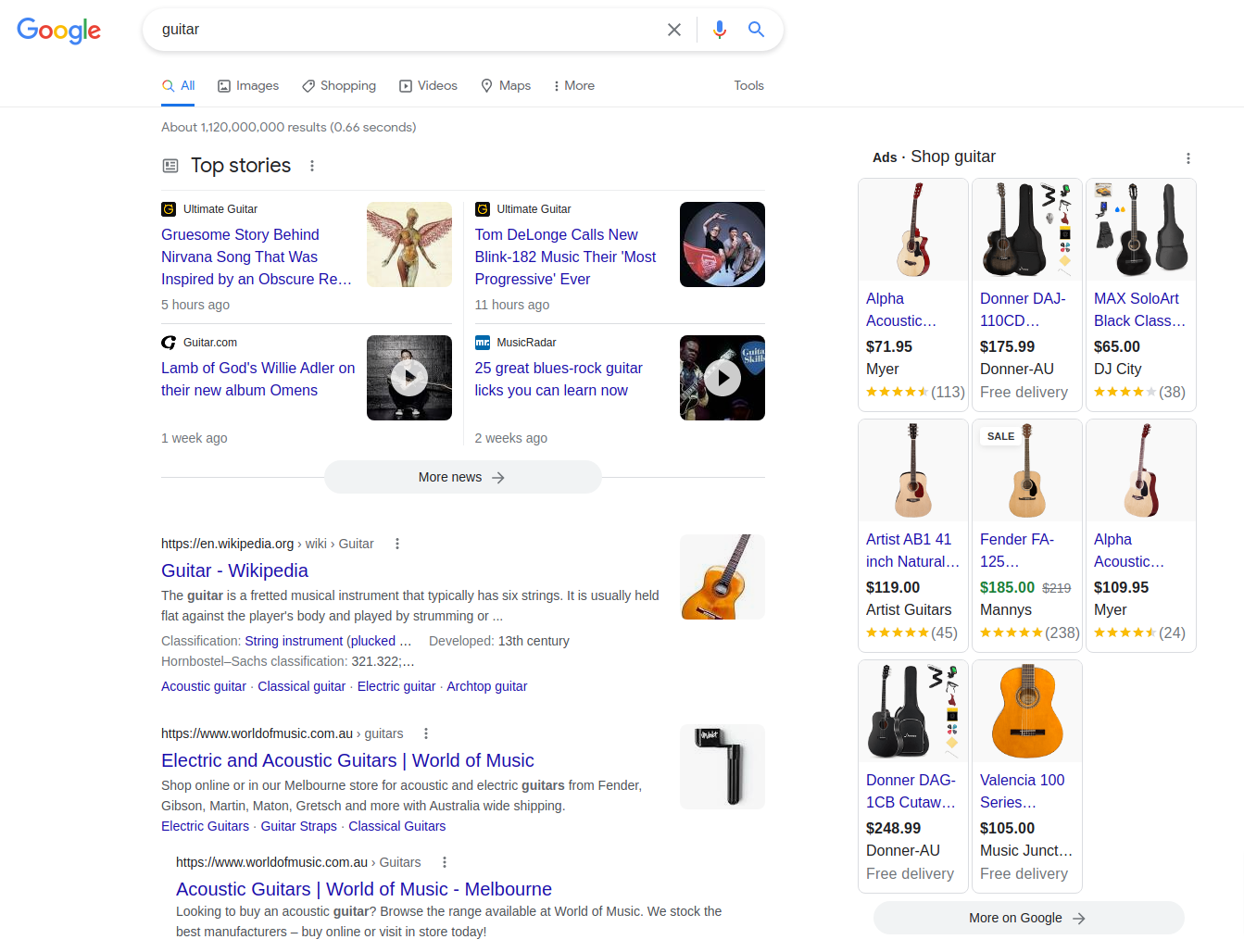
Many of the websites that appear on this Search Engine Results Page (SERP) will have used SEO techniques to target those who search the word ‘guitar’.
Typing in a generic search term like ‘guitar’ will likely return all sorts of content that has some connection to ‘guitars’ from information on how guitars are made, to online guitar courses and music stores trying to sell guitars online.
So, keywords are pretty simple. But what makes a keyword ‘long-tail’?
When websites first realized that they could adopt SEO best practices in order to rank high on SERPs, they would typically target short one or two-word keywords – such as ‘guitar’ or ‘electric guitar’. These are now known as short-tail keywords.
As SEO knowledge developed, websites noticed that they could also get good results from targeting longer, more specific keywords. For example, these may include phrases like ‘Gibson Les Paul electric guitar’, ‘where can I buy an electric guitar’, or ‘learn to play electric guitar online’.
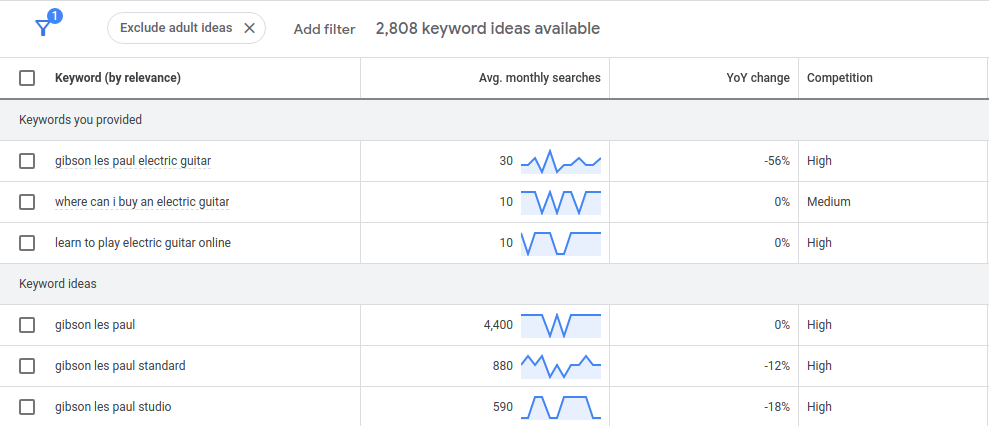
This is what we mean when we describe a keyword as being long-tail.
This approach provided unique benefits, which we will explore in more detail later in this guide.
How Do Long-Tail Keywords Work?
Long-tail keywords work by matching search queries more closely. This is especially true as internet users have become increasingly savvy on how to get the best results when using search engines.
Let’s stick with our guitar example. But now we need to introduce a searcher – let’s call him Tommy.
Tommy really wants to learn how to play the electric guitar. It’s been his dream ever since he was a young boy listening to pop punk in his bedroom.
So, like most people, he starts his journey by opening Google in his internet browser.
Now, Tommy knows that if he just types in ‘guitar’ he is likely to be presented with a large volume of website options that aren’t really going to help him achieve his goal.
We have already seen this is true in the screenshot of the SERP for ‘guitar’ above. Recent news about famous guitar players and a Wikipedia page about “what a guitar is” may be interesting, but it isn’t going to help him learn to ‘shred’ like his favorite players.
So, he gets more specific with his searches. First, he needs to find a guitar to learn on, so he types:
‘Great guitars for beginners’
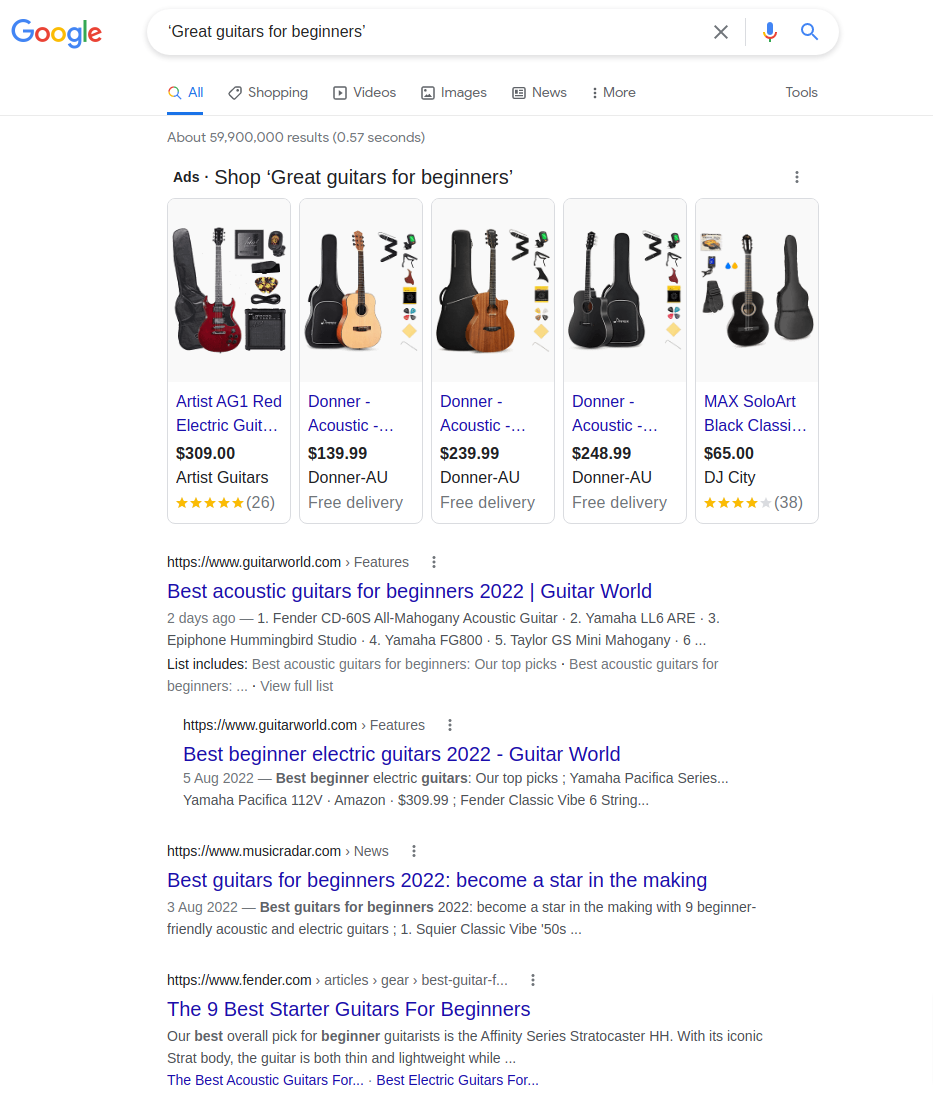
…he reads a few articles on which guitars are best for those just starting out.
Based on this advice he decides he wants to invest in an entry-level guitar – the Fender Squire.
His next search is:
‘Best deals on Fender Squires’
He finds the best deal, makes his order, and gets his guitar in the posts.
Now he has a shiny new guitar in his hands, he is ready to make more specific searches such as ‘basic guitar scales’ or ‘beginners online guitar course’ in order to continue his journey.
Why Use Long-Tail Keywords?
As you can see from the section above, when your website targets long-tail keywords you are able to attract an audience that is much more specific to what you offer.
For example, if you are a guitar store, targeting the keyword ‘guitar’ may pull some people who are interested in buying a guitar to your website.
However, a large volume of those visitors may be looking for things that are irrelevant such as simply wanting to know what a guitar is or what the latest news in the guitar world is.
On the other hand, if the same guitar store targeted long-tail keywords such as ‘where to buy a guitar’ and ‘buy Fender Squire’ then they are much more likely to attract traffic that has real intent on making a purchase.
There are other benefits to targeting long-tail keywords as well.
For example, when you are more specific about the keywords you target, you are less likely to have to overcome as much competition in order to rank highly for those keywords.
For variety, let’s switch up our example to an online bakery that delivers fresh bread locally.
To simplify matters, let’s say this bakery has to pick from two keywords to target on its website:
- Bread
- Fresh bread delivery near me

Ranking for the first keyword ‘bread’ is likely to take a considerable amount more time and effort.
This is not only because other online bakeries are targeting this keyword, but other websites will also be fighting to rank for this term.
Here are just a few that could be targeting the keyword ‘bread’:
- Local bakeries that don’t deliver
- Bread recipe websites
- Stores that sell the ingredients to make bread
- Businesses that manufacture breadmakers
- Organizations that uphold the standards of the bakery industry
- News
…the list goes on.
On the other hand, ranking for the second keyword ‘Fresh bread delivery near me’ is likely to only generate competition from others who are in your exact niche.
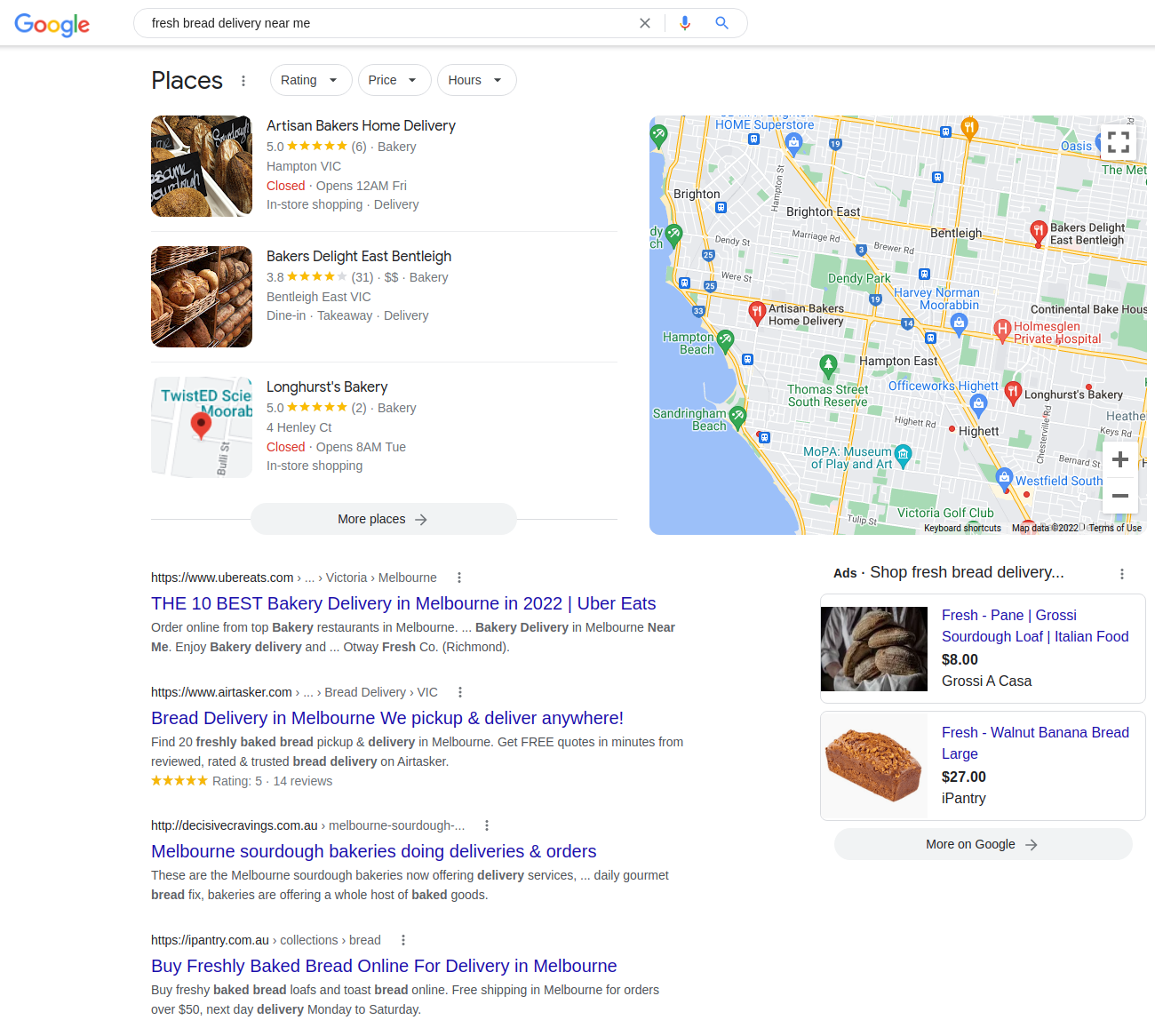
Sure, the volume of traffic for ‘bread’ is significantly higher (10K-100K average monthly searches) when compared to ‘fresh bread delivery near me’ (100-1K average monthly searches).
But it will also be much harder to rank for AND those who are searching using the term ‘bread’ are less likely to be seeking exactly what you provide.
To put this in context, let’s say that perhaps just 20% of those searching for ‘bread’ are looking to purchase bread online. Other searchers could be looking for any of the other businesses, organizations, and websites we have listed above.
However, almost 100% of those searching for ‘Fresh bread delivery near me’ are looking to purchase bread from a local bakery that delivers.
To put it simply:
The more specific the keyword, the easier it is to rank for AND the more valuable the traffic.
What Makes a Good Long-Tail Keyword?
Ranking your website for a keyword (long-tail or short-tail) can take a considerable amount of time, effort, and skill. So, you really want to find high-value keywords to target in order to get the greatest return on investment for your SEO efforts.
After all, there is no point in ranking highly for a long-tail keyword if there are very few searchers and if those searchers are very unlikely to be interested in what your website offers.
Finding good long-tail keywords is all about striking a balance between three key elements:
- Search Volume
- Competition
- Relevance
Search Volume
This is how many people are searching using a given long-tail keyword.
Reports on search volume are typically given over a specific time period. For example, one long-tail keyword may be searched for an average of 100K times in a month.
Whereas another will only be searched for an average of 100 times in the same time period. The higher the search volume, the more potential clicks your website will get if you can rank highly for that keyword.
Competition
The more websites that target a given keyword, the harder it is likely to be to rank highly for that keyword on SERPs.
Typically, you will find that keywords with very high search volumes also have very high competition.
However, taking a long-tail approach can make it easier to find highly valuable keywords that have high search volumes and low competition.
Relevance
As tools typically won’t tell you exactly how relevant a keyword is to your website, relevance is often overlooked when it comes to determining what makes a good keyword. Yet it is inarguably the most important factor.
Finding relevant keywords (short and long-tail) is crucial to success. We will demonstrate this in the examples we give below.
Not all of the factors we have listed above carry the same weight. Here are a few examples of how getting the right mix can really impact the real-world success of a keyword strategy:
Long-Tail Keyword Combinations
- Search volume = High
- Competition = Low
- Relevance = Very low
At first glance, this keyword might seem great.
With a huge number of searches every month and practically no competition, this keyword is likely to be very easy to rank for and could bring a huge volume of visitors to your website.
But how valuable is that if the keyword is irrelevant to what you offer?
All that targeting this keyword will do is bring lots of people to your website who have no real interest in what you have to say or sell.
Ultimately resulting in a drop in page session and a huge boost in bounce rate.
Also very rare, you would not see keywords with high volumes and lower competition often.
- Search volume = Very low
- Competition = Medium
- Relevance = Very high
Again, at first glance, this keyword could be misleading. With very few searches a month and a medium level of competition – what is the point of targeting it?
Well, high relevance can mean that this keyword is highly valuable.
Let’s take for example a long-tail keyword/search query that may look like this:
“Where to buy [insert luxury car name] in London”
Not many people may be able to afford that particular car, which is why search volume is incredibly low. Yet just converting one searcher may mean a huge amount of profit for a specialist car dealer – making the keyword high value, even though it isn’t high volume.
Relevance is always important, but it is especially important when it comes to those who serve a small niche or sell high-price products and services.
- Search volume = High
- Competition = Low
- Relevance = High
This combination can be considered the ‘holy grail’ for many websites.
High search volumes mean you have more opportunities to convert searchers into website visitors. The fact that competition is low means that it could be relatively easy to rank for this keyword. Plus, as the keyword is highly relevant to your website, each visitor you receive is more likely to be of value.
Of course, finding this combination is incredibly rare, especially in niches with considerable amounts of competition.
How to Find Long-Tail Keywords
So far in this guide, we have established a few things:
- What long-tail keywords are
- How long-tail keywords work
- Why you should be targeting long-tail keywords
- What makes a great long-tail keyword
So, at this point, you are probably asking:
“That is all great, but how do I actually find the right long-tail keywords for my website?”
It’s a great question and one we are about to answer in detail. In the next part of the article, we dive into how to find the best long-tail keywords that are going to help you drive more, super-relevant, and engaged traffic to your website.
We have broken this into three sections which will help you find long-tail keywords that are the perfect mix of search volume, competition, and relevance.
In the first section, we detail the approach that websites should be taking to find the best long-tail keywords for them. Section two ‘Customer Research’, is often overlooked but will ultimately help you nail the ‘relevance’ element of the magic long-tail formula. Finally, we explore the best tools out there to help you find better keyword ideas and asses the volume and competition aspects of your keywords.
Long-Tail Keywords Approach
Before we dive into how to find the best long-tail keywords for your business, it is important to understand the ways you structure your keywords in order to get the best result.
To do this, you need to understand the concept of search intent.
Search Intent
Search intent can be described as the main goal of a person who is using a search engine. By understanding their intent you can match your long-tail keywords to what they would actually type into the search box.
Let’s say someone wants to cook a vegan pasta dish, but they aren’t a confident cook. Their search may look something like this:
‘Easy vegan pasta dish recipes”
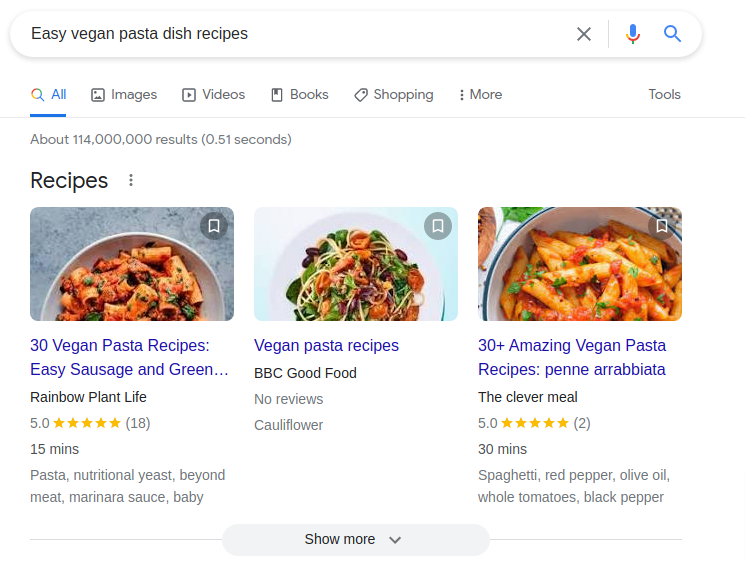
Understanding how people will search for your website will help you target those exact long-tail keywords. There are a few different approaches to doing this:
Target Questions
Modifiers such as ‘what’, ‘how’, and ‘why’ are often added to searches in order to help the searcher find the exact information they are looking for.
For example, if you run a blog that teaches people how to fly fish, your target audience may be typing the following queries into search engines:
- ‘What is fly fishing?’
- ‘How do I get started with fly fishing?’
- ‘Why is fly fishing better than float fishing?’
By targeting these types of questions you will be able to drive relevant traffic to your site.
Add Descriptors
Often searchers will be looking for a specific type of product, service, or content in order to meet their needs.
By adding qualifiers to your keywords you can better target those who are likely to be valuable to you.
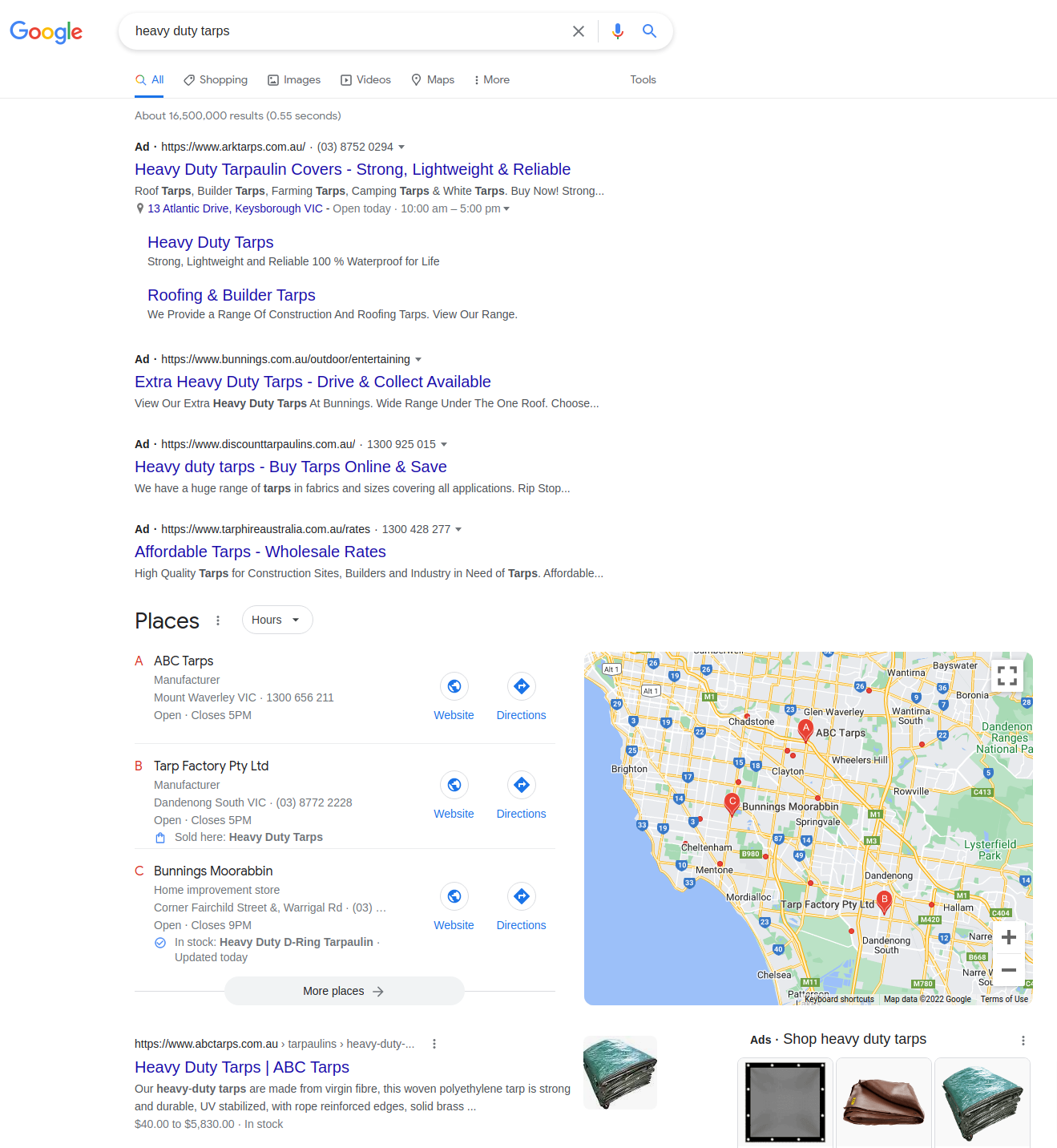
For example, the short-tail product keyword of ‘tarps’ may be used alongside qualifiers such as ‘lightweight’, ‘heavy duty’, or ‘large’ in order to target individuals with different needs.
Similarly, you may add descriptors to content in order to help better match it to those it will help such as:
‘Beginners guide to SEO’ or ‘Advanced SEO tactics for SEO professionals’.
Add Specifications
Another approach to finding long-tail keywords is using specifications.
For example, a luxury car dealership may target the short-tail keyword of ‘ luxury cars’, but would benefit more by targeting a specific model such as ‘classic Porche 911’.
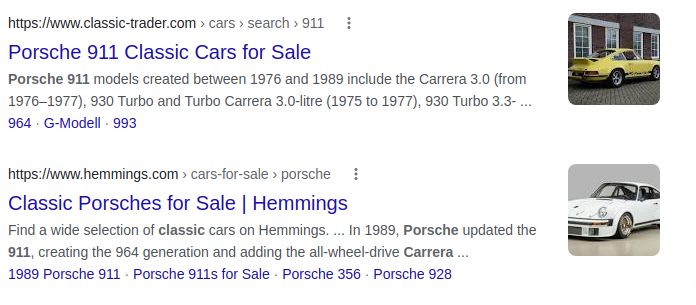
Long-Tail Keywords Customer Research
Now we have outlined some of the best approaches to long-tail keywords, it is time to focus on how to actually find keywords that will be beneficial to your website. Customer research is often overlooked during this process, but will ultimately help you find keywords that are more relevant.
At this stage, you may want to gather information directly from customers (via survey or interview). Alternatively, you could use already well-established internal knowledge from within your business.
Ask:
- What questions are you commonly asked by your customers/visitors?
- What terms do your customers use for your products/services?
- What actual issue are you solving for your customer/visitors?
Answering these questions will be invaluable as they will allow you to conduct further research with the customer in mind.
To illustrate how useful this information will be consider an online store that sells light fittings. Depending on who their main customers are will influence how their products are commonly searched for.
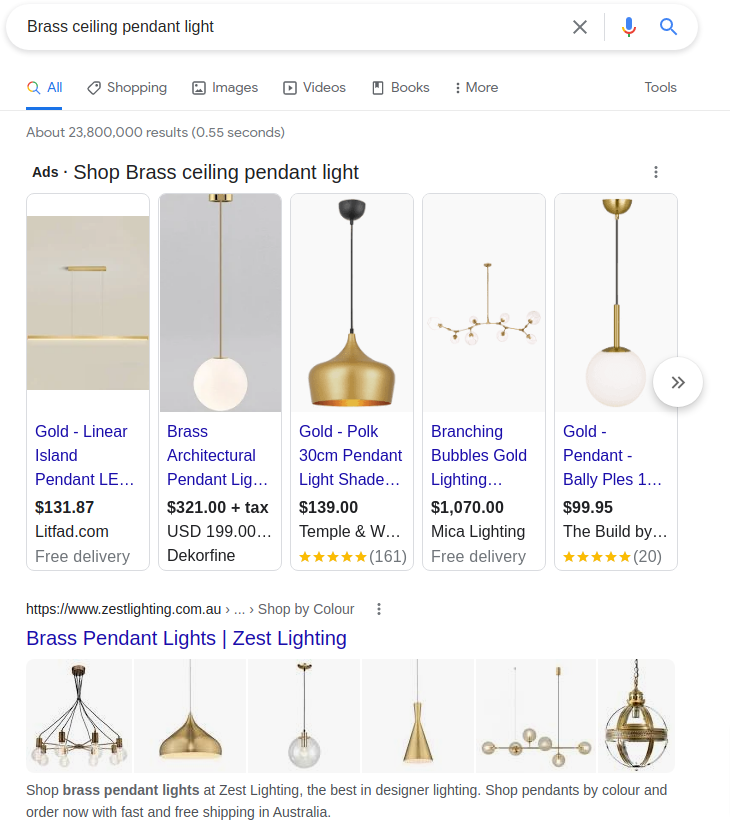
For example, your average homeowner may search for:
‘brass ceiling pendant light’
Whereas a professional electrician is more likely to search using specifications such as compatibility, power requirements, and measurements.
Having information on who your customers/visitors are will help focus the rest of your long-tail keyword search efforts.
Long-Tail Keywords Tools
So, we have established the approach we should be taking when finding long-tail keywords for our website.
Although this approach can be taken in isolation, there are two issues with doing this:
- You are limited to the long-tail keywords you and your team can think of as a result of customer research
- You won’t know how hard it will be to rank for those keywords, or how much traffic they will actually bring to your website
Using keyword tools can help you overcome these issues by offering you long-tail keyword ideas you may not have considered and providing you with the data you need to know whether that long-tail keyword is actually worth targeting on your website.
In this section, we list some of the best keyword tools available.
Google Search
Google search is by far the best place to start your hunt for long-tail keywords. Simply:
- Visit Google.com
- Type in your short-tail keyword (such as your product or website topic)
- Review the search suggestions that Google makes and write down the ones which are relevant to your site and customers
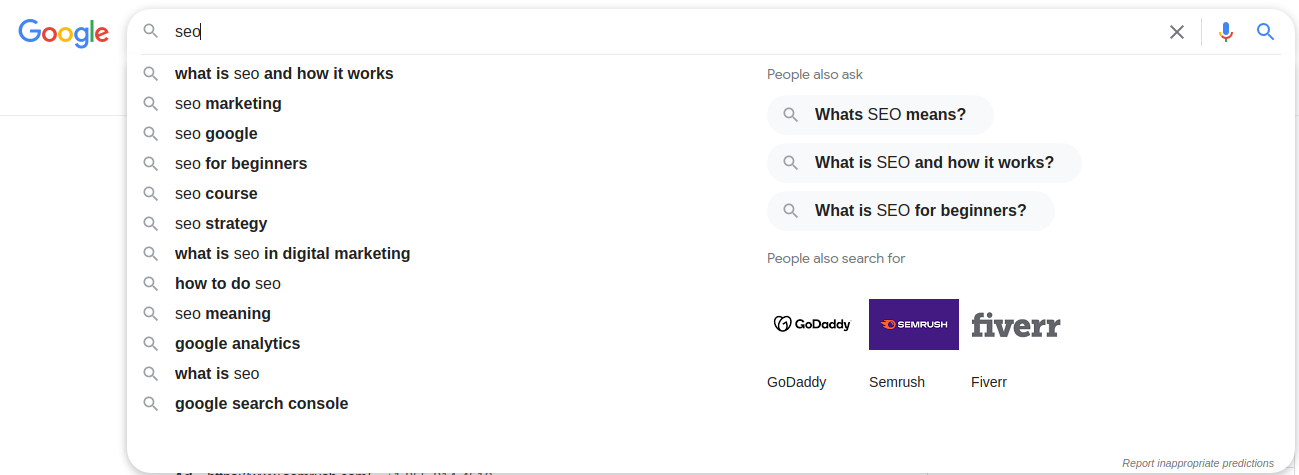
Google Keyword Planner
Google Keyword Planner is a free tool by Google that offers valuable insight into long-tail keywords.
- Go to Google Keyword Planner
- Click ‘Discover New Keywords’
- Type in your short-tail keywords (such as your product type or website topic)
- Check out the suggestions
This tool will offer you insight into key information such as search volumes and competition. So, it is also useful for sense-checking any keyword ideas you get from other methods.
Google Trends
The third and final tool from Google that makes this list is Google Trends. This site will let you know how popular your keywords have been.
Reviewing the Top and Rising ‘Related Terms’ section will also provide you with other good ideas.
- Visit Google Trends
- Type in your short or long-tail keyword
- Scroll down to the Related Terms section to find other suggestions.
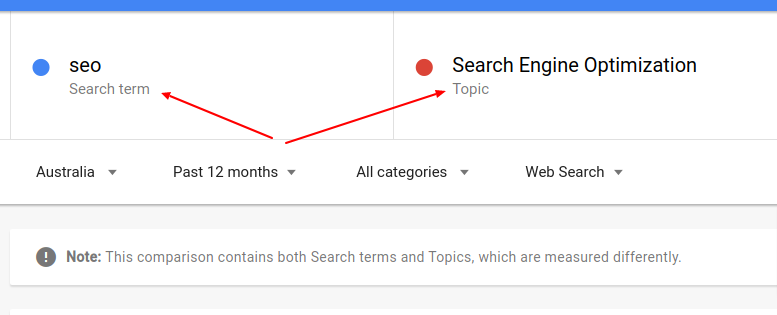
Answer The Public
AnswerThePublic is a fantastic tool that offers you many long-tail keyword suggestions that you can target via your website.
Once you type your keyword into the search bar it will return results in multiple categories including questions, prepositions, and comparisons – offering you great insight into how your keywords are being searched for online.
Ubersuggest
Ubersuggest is a keyword tool that works in a similar way to Google Keyword Planner. Simply visit the Ubersuggest website, type in your domain, the domain of a competitor, or a keyword and it returns helpful insights such as:
- Data on that keyword
- Other keyword suggestions related to that keyword
- Popular content ideas related to that keyword
Although Ubersuggest offers 3 daily free searches, for more advanced insights and more searches you will need to pay for an account.
Semrush
A competitor to Ubersuggest, Semrush offers similar insights and suggestions and is another option for those that want to get serious about long-tail keyword research.
Semrush doesn’t have a free version and costs more than Ubersuggest, but can be better for more advanced users.
KWFinder
Another market-leading keyword tool is KWFinder. This tool provides users with a whole host of useful keyword information including similar websites, keyword ideas (with search and competition data), and competitors which are ranking well/driving high volumes of traffic.
This is another tool that website owners need to invest in in order to benefit from, but can drastically decrease the time it takes to find actionable data when it comes to SEO and finding relevant information on long-tail keywords.
Summary
It is clear that long-tail keywords can be incredibly beneficial for the websites that take the time and effort to target them. Although search volumes for these types of keywords are typically much smaller than their short-tail counterparts, the intent behind those searches is often much greater and therefore can be more beneficial for all websites.
Using this guide will not only help you better understand what long-tail keywords are and how they work, but it will also arm you with everything you need to find the very best long-tail keywords for your website.
So, what are you waiting for? Get out there, find some great keywords and start driving traffic to your website today.
FAQs
What are long-tail keywords?
Long-tail keywords are keywords that are typically 3+ words in length. Unlike short-tail keywords which are often generic in nature, long-tail keywords allow websites to be more specific in who they attract. Long-tail keywords often take the form of questions such as ‘how much do I need to save to buy a house’ or include descriptors such as ‘lightweight camping gear’.
Which tools can I use to find long-tail keywords?
There are countless tools out there dedicated to helping you find the best keywords for your website. Some of these include free tools from Google such as Google Search, Google Keyword Planner, and Google Trends. Other paid tools such as Semrush and Ubersuggest and be a good way to get deeper insights.
Are long-tail keywords worth targeting?
Yes. Although long-tail keywords typically have smaller volumes of search traffic than short-tail keywords, they are also much more specific in nature and have less competition. This means that although you will get less traffic to your site, the traffic you do get will be more likely to be relevant to what you offer and will ultimately be easier to earn.
